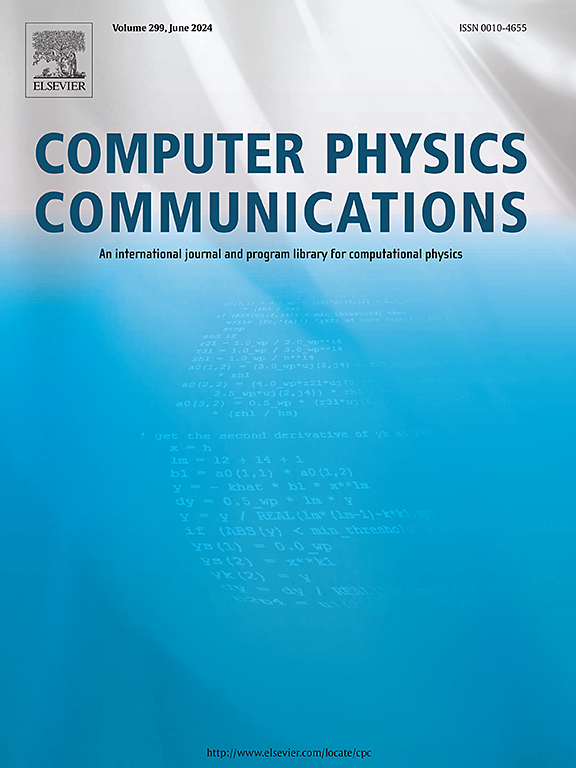ERMES 20.0: Open-source finite element tool for computational electromagnetics in the frequency domain
IF 7.2
2区 物理与天体物理
Q1 COMPUTER SCIENCE, INTERDISCIPLINARY APPLICATIONS
引用次数: 0
Abstract
ERMES 20.0 is an open-source software which solves the Maxwell's equations in frequency domain with the Finite Element Method (FEM). The new ERMES 20.0 is a significant upgrade from the previous ERMES 7.0 [1]. It introduces new features, modules, and FEM formulations to address the challenging problems commonly encountered in the design and analysis of nuclear fusion reactors [2]. Key additions are the electrostatic and cold plasma module, along with new FEM formulations as the stabilized double-curl edge element formulation [3] and the local projection method with nodal and bubble elements [4,5]. Furthermore, all the formulations now include an A-V potentials version. The ample set of methods available in the new ERMES 20.0 allows the user to select the most suitable FEM formulation to generate the best possible conditioned matrix for each specific problem.
ERMES 20.0 operates in the static, quasi-static and the high-frequency regimens, making it a versatile tool which can be used in a wide variety of situations. For instance, it had been applied to microwave engineering, bioelectromagnetics, and electromagnetic compatibility. Now, thanks to the new electrostatic and cold plasma modules, the range of applications has been extended to relevant nuclear fusion engineering problems as: the computation of induced forces, plasma control, probability estimation of electric arc initiation, current distribution in arbitrary geometries, and the study of electromagnetic wave-plasma-wall interactions inside a fusion reactor.
ERMES 20.0 is available for Windows and Linux systems and it has improved its capabilities to solve large problems on High Performance Computing (HPC) infrastructures thanks to its new interface with the solver libraries PETSc [6] and Python NumPy [7]. As in previous versions, ERMES 20.0 features a graphical user-friendly interface integrated into the pre- and post-processor GiD [8]. GiD handles geometrical modeling, data input, meshing, and result visualization. ERMES 20.0 is licensed under the open-source software 2-clause BSD license.
This document is accompanied by a comprehensive manual that provides a step-by-step installation guide, a detailed description of all the new features and formulations, as well as the executables, user interface, examples, and source code of ERMES 20.0.
New version program summary
Program Title: ERMES 20.0
CPC Library link to program files: https://doi.org/10.17632/v946dvxn54.1
Developer's repository link: https://ruben-otin.blogspot.com/
Licensing provisions: BSD 2-clause
Programming language: C++
Journal reference of previous version: Comput. Phys. Commun. 184 (11) (2013) 2588–2595
Does the new version supersede the previous version?: Yes
Reasons for the new version: This new version is a significant upgrade of the previous version [1], introducing a suite of new features, modules, and FEM formulations.
Summary of revisions: This document is accompanied by a comprehensive manual that provides a detailed description of all the new features.
Nature of problem: Time-harmonic Maxwell's equations.
Solution method: Finite Element Method.
References
- [1]R. Otin, ERMES: A nodal-based finite element code for electromagnetic simulations in frequency domain, Comput. Phys. Commun. 184 (11) (2013) 2588–2595.
- [2]R. Otin et al., Computational electromagnetics for nuclear fusion engineering and design, NAFEMS Benchmark Mag. (Jan. 2020) 60–68.
- [3]P. Monk, Finite Element Methods for Maxwell's Equations, Oxford University Press, 2003.
- [4]H. Duan, P. Lin, R.C.E. Tan, Solving a Maxwell interface problem by a local projected finite element method, in: ENUMATH 2013, Numer. Math. Adv. Appl. 103 (2015) 795–802.
- [5]H. Duan, R.C.E. Tan, S.-Y. Yang, C.-S. You, Computation of Maxwell singular solution by nodal-continuous elements, J. Comput. Phys. 268 (2014) 63–83.
- [6]PETSc, PETSc: the portable, extensible toolkit for scientific computation, 2024 [Online]. Available at: https://petsc.org.
- [7]NumPy, NumPy: the fundamental package for scientific computing with Python, 2024 [Online]. Available at: https://numpy.org.
- [8]GiD, GiD: the personal pre- and post-processor, 2024 [Online]. Available at: https://www.gidsimulation.com.
求助全文
约1分钟内获得全文
求助全文
来源期刊

Computer Physics Communications
物理-计算机:跨学科应用
CiteScore
12.10
自引率
3.20%
发文量
287
审稿时长
5.3 months
期刊介绍:
The focus of CPC is on contemporary computational methods and techniques and their implementation, the effectiveness of which will normally be evidenced by the author(s) within the context of a substantive problem in physics. Within this setting CPC publishes two types of paper.
Computer Programs in Physics (CPiP)
These papers describe significant computer programs to be archived in the CPC Program Library which is held in the Mendeley Data repository. The submitted software must be covered by an approved open source licence. Papers and associated computer programs that address a problem of contemporary interest in physics that cannot be solved by current software are particularly encouraged.
Computational Physics Papers (CP)
These are research papers in, but are not limited to, the following themes across computational physics and related disciplines.
mathematical and numerical methods and algorithms;
computational models including those associated with the design, control and analysis of experiments; and
algebraic computation.
Each will normally include software implementation and performance details. The software implementation should, ideally, be available via GitHub, Zenodo or an institutional repository.In addition, research papers on the impact of advanced computer architecture and special purpose computers on computing in the physical sciences and software topics related to, and of importance in, the physical sciences may be considered.
 求助内容:
求助内容: 应助结果提醒方式:
应助结果提醒方式:


